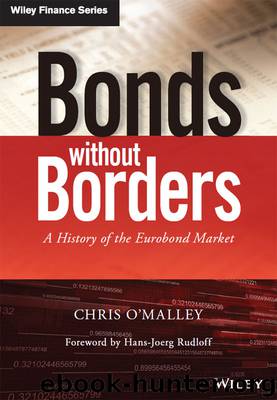Bonds without Borders by Chris O'Malley

Author:Chris O'Malley [O’Malley, Chris]
Language: eng
Format: epub
ISBN: 9781118843871
Publisher: Wiley
Published: 2014-10-09T00:00:00+00:00
* * *
More than anything else, the 1990s was the decade of Europe and European convergence. It began with the reunification of Germany in 1990. As the deadline for reunification approached the German government bond market came under considerable pressure sending 10-year Bund yields to their highest level for five years. ‘The main fear for the fixed income markets has been that the high speed of reunification could lead to a huge public sector deficit which could re-ignite inflation, boost interest rates and undermine the deutschemark, the anchor of the European Monetary System.’14 A particular concern was that East German marks might be exchanged for West German deutschemarks at a rate of one-for-one. This had been a pre-election pledge of ex-Chancellor Helmut Kohl, despite the fact that inflation, at the time, was running at 20% in East Germany and only 2.6% in the West, and the Ostmark was trading at a rate of between five and ten to one deutschemark on the black market. The conservative Bundesbank advocated a 2-to-1 exchange rate. However, fearing a mass exodus from East Germany if the German government didn't give the East the deutschemark, the political and social arguments won the day. Investor fears were realised when currency union, largely at a one-for-one rate, was officially announced in April 1990 and took effect in July.
Suddenly, East German firms had to compete with western firms at the same level of prices, wages and costs – despite a much lower level of productivity. Industrial output dropped by 35% in one month, July 1990, and in the next month by another 15%. Unemployment soared and migration west continued. Unemployment and falling tax income led to mounting budget deficits: from 5% to 13.2%. By 1991 the Bundesbank was becoming very nervous about the prospects of high inflation and so started pursuing a contractionary monetary policy.
The combination of expansionary fiscal and contractionary monetary policy caused German rates to rise dramatically – about 3% in 1991 and 1992. The high German rates made a difficult situation for the UK, France, Italy and other European countries worse as they were restrained from taking corrective monetary policy actions. The outcome would be the crises of the European Monetary System (EMS) in autumn 1992 and July 1993.
Der Spiegel commented: ‘Before the fall of the Berlin wall, European monetary union had been an ambitious EEC project like so many others. Afterward it was the central political tool with which to bind the expanded Germany to the European community.’15
Maastricht is the best known and perhaps the most controversial of the European treaties. Signed in the Dutch town of Maastricht on 7 February 1992, it became renowned not only for difficult negotiations in drafting it, but also for the difficulties many Member States had in approving it. It significantly advanced the agenda set out under the Single European Act (SEA). Maastricht is officially known as the Treaty of the European Union and with it the EU came into existence for the first time. By adding two
Download
This site does not store any files on its server. We only index and link to content provided by other sites. Please contact the content providers to delete copyright contents if any and email us, we'll remove relevant links or contents immediately.
The Black Swan by Nassim Nicholas Taleb(6763)
Bad Blood by John Carreyrou(6274)
Pioneering Portfolio Management by David F. Swensen(6078)
Millionaire: The Philanderer, Gambler, and Duelist Who Invented Modern Finance by Janet Gleeson(4093)
Skin in the Game by Nassim Nicholas Taleb(3965)
The Money Culture by Michael Lewis(3846)
Bullshit Jobs by David Graeber(3829)
Skin in the Game: Hidden Asymmetries in Daily Life by Nassim Nicholas Taleb(3722)
The Wisdom of Finance by Mihir Desai(3523)
Blockchain Basics by Daniel Drescher(3329)
Liar's Poker by Michael Lewis(3220)
The Intelligent Investor by Benjamin Graham Jason Zweig(2930)
Hands-On Machine Learning for Algorithmic Trading by Stefan Jansen(2925)
Mastering Bitcoin: Programming the Open Blockchain by Andreas M. Antonopoulos(2891)
Fooled by Randomness: The Hidden Role of Chance in Life and in the Markets by Nassim Nicholas Taleb(2860)
Investing For Dummies by Eric Tyson(2793)
The Power of Broke by Daymond John(2772)
Market Wizards by Jack D. Schwager(2538)
Zero Hour by Harry S. Dent Jr. & Andrew Pancholi(2532)
